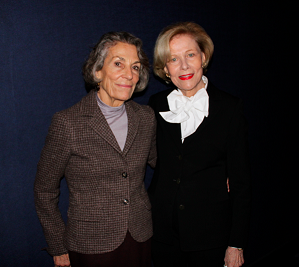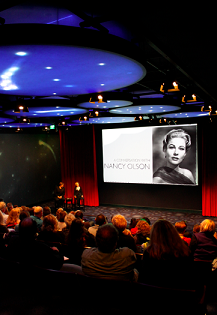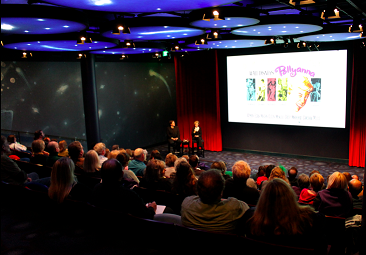Last Saturday March 17, The Walt Disney Family Museum had the honor of presenting an intimate conversation with a beloved actress of stage and screen: Nancy Olson. The event was filled with film clips and several interesting, behind the scenes anecdotes from Ms. Olson’s life and career.
Before introducing Nancy Olson and moderator Jeff Kurtti, Diane Disney Miller opened the event with a few remarks about how special the movie Pollyanna is to her and her family. It was filmed in nearby Napa and Santa Rosa with an illustrious cast, which included Jane Wyman, Agnes Moorehead, Hayley Mills, and, of course, Nancy Olson. This heartwarming and optimistic story, told through strongly developed characters, has made the movie a favorite of Disney fans and ranks as one of the best live-action features Walt Disney had ever produced.
 Jeff Kurtti, who has served as creative director and content consultant for The Walt Disney Family Museum, opened by asking Ms. Olson how she came to Hollywood after growing up in Milwaukee, Wisconsin. Thus began a fascinating hour of first hand, candid, and humorous recollections that gave the audience an appreciation for Nancy Olson’s journey through Hollywood, Broadway, and silver screen immortality.
Jeff Kurtti, who has served as creative director and content consultant for The Walt Disney Family Museum, opened by asking Ms. Olson how she came to Hollywood after growing up in Milwaukee, Wisconsin. Thus began a fascinating hour of first hand, candid, and humorous recollections that gave the audience an appreciation for Nancy Olson’s journey through Hollywood, Broadway, and silver screen immortality.
Nancy Olson recalled wanting to be an actress ever since junior high school in Milwaukee, Wisconsin where her father was a doctor. She appeared in several school productions up through high school. “I enjoyed the applause, I must admit”, she remembered. She recalled noticing the audience becoming quiet as she simply entered the stage during a performance. She then realized the attention and respect that an actor could be accorded by an audience and knew that acting would be her calling. She attended the University of Wisconsin where she appeared in stage productions and was part of the state champion debate team.
One summer she decided to attend summer school at UCLA. Being a member of the Kappa Kappa Gamma sorority at UW, she could save expenses by staying at the UCLA sorority house. While at UCLA, Nancy joined the theater arts department and appeared in several productions ranging from Shakespeare to musicals. After one of the performances, she was invited to do a screen test for Paramount. The result was positive and she was signed to a seven year contract. Given her new responsibility, Nancy Olson did not return to the University of Wisconsin and remained at UCLA while under contract.
In 1950, at age 21, Ms. Olson was chosen to play the role of Betty Schaefer, an aspiring screenwriter, opposite William Holden in the classic film Sunset Boulevard. After screening two scenes from the film, Nancy shared some anecdotes related to the production. In one scene, her character Betty Schafer admits to having had her nose fixed. In real life, Ms. Olson’s nose is straight, but for years after, she received mail from fans asking “who fixed your nose?” because whoever had done the work on her character was obviously very good. In another recollection, she recounted shooting the “balcony kiss” scene. Nancy was a bit apprehensive at having a first kiss with a big star like William Holden. To add to the concern, there was a party prior to the nighttime shooting of the scene and some of the cast and crew wives were present. The director, Billy Wilder, asked that she and William Holden hold their embrace and kiss for an extended period to allow for a clean edit into a following scene. The scene unfolded and, as instructed, Holden and Olson held their embrace and actually got into their extended kiss. The passionate silence was broken when, from below, a female voice shouted “cut dammit!” It was Mrs. Holden, who obviously felt the acting had gone beyond the call of duty. William Holden and Nancy Olson went on to become good friends. Hollywood noticed the on-screen chemistry between the two and they were cast in three more features together over the following year; Union Station (1950), Force of Arms (1951) and Submarine Command (1951).
Nancy Olson received an Academy Award nomination for Best Supporting Actress for Sunset Boulevard. Quite an accomplishment for a new young actress. The movie went on to be part of the original group of films selected in 1989 by the National Film Preservation Board (established in 1988 by the Library of Congress) for induction, based on its cultural, historical and aesthetic merit. Other films selected that inaugural year included: Citizen Kane, Casablanca, Gone With The Wind, Snow White and the Seven Dwarfs and The Wizard of Oz to name a few. This is illustrious company indeed and is evidence of the high regard in whichSunset Blvd. is held. Nancy Olson commented how pleased she is to have been a part of a “masterpiece”. It means that her great grandchildren and beyond will get to see her performance far into the future. Despite her success, Nancy Olson admitted to being a bit of a disappointment to her parents whose Midwestern values dictated that a college degree should be completed. She had, of course, left UCLA to pursue her acting career without earning her degree.
Ms. Olson candidly pointed out that her experience in Hollywood was not as fulfilling as she had hoped. She encountered lecherous producers and her leading men tended to be married. While she enjoyed acting, she did not want to be a “movie star”. It was during this time that she met Alan Jay Lerner, the famed Broadway librettist, who had just completed the hit Brigadoon and had begun work on An American in Paris. They were married and Nancy Olson left Hollywood to raise a family in New York. While there, she took time to perform on the Broadway stage in such productions as Tunnel of Love, and Send Me No Flowers, and Mary, Mary.
Nancy Olson remembered that, as Alan Lerner was working on My Fair Lady, a song was needed to show the love that Henry Higgins had for Eliza Doolittle, but could not express. She recounted one day when she brought lunch downstairs for Alan, he commented “you have a very pretty face”, to which she responded, “you just noticed?!” Alan went on to say, “I’ve grown accustomed to your face”, after which he thoughtfully paused and realized he had the foundation for the song he needed for Henry Higgins. My Fair Lady, which was dedicated to Nancy, went on to be a highly successful Broadway show and, later, an Oscar®-winning Best Picture.
 The marriage did not last, however, and Nancy found herself alone raising her two daughters. After a long hiatus from the screen, Nancy received a call from her agent stating that Walt Disney had asked if she would consider being in a new type of film he was producing that would boast top notch Hollywood acting talent. She had planned to go to California anyway and agreed to test for the part of Nancy Furman, the housemaid in Pollyanna. She was offered the part and accepted. She noticed immediately how different the Walt Disney Studios were from the other Hollywood studios. It was clean and there was a sense of family. It was an outgoing and friendly atmosphere, she remembered. She and Walt Disney understood each other. They both had a Midwestern upbringing and therefore understood one another from the beginning.
The marriage did not last, however, and Nancy found herself alone raising her two daughters. After a long hiatus from the screen, Nancy received a call from her agent stating that Walt Disney had asked if she would consider being in a new type of film he was producing that would boast top notch Hollywood acting talent. She had planned to go to California anyway and agreed to test for the part of Nancy Furman, the housemaid in Pollyanna. She was offered the part and accepted. She noticed immediately how different the Walt Disney Studios were from the other Hollywood studios. It was clean and there was a sense of family. It was an outgoing and friendly atmosphere, she remembered. She and Walt Disney understood each other. They both had a Midwestern upbringing and therefore understood one another from the beginning.
Ms.Olson shared a memory of Hayley Mills coaching her younger brother, Jonathan, who was preparing for an audition. Haley told her brother, “look straight at the camera and mean what you say.” It was simple and yet profound advice from such a young actress. Nancy stated that she really enjoyed working with the film’s director David Swift. He had a certain “joie d’vivre”, a kind man whose enthusiasm was infectious she recalled.
Nancy Olson’s relationship with the Disney Studios continued in The Absent Minded Professor (1961) and Son of Flubber (1963) playing opposite Fred MacMurray. She said that MacMurray was the consummate professional actor with a wonderful sense of comedic timing. During this period, Nancy met and married her second husband, the late Alan Livingston. Livingston had an accomplished career and was responsible for the creation of the popular Bonanza television series and the character of Bozo the Clown. He signed Frank Sinatra to Capitol Records after Sinatra left Columbia.
Nancy Olson ended the program by pointing out how much Walt Disney and his family have supported the arts. Not only through the motion pictures that Walt produced, but through his patronage of CalArts and Lillian Disney’s generous gift which resulted in perhaps the finest music venue in the world, The Walt Disney Concert Hall. The legacy continues today with The Walt Disney Family Foundation’s creation of the The Walt Disney Family Museum, which includes the charming theater in which this event was held.
The hour of conversation with Academy Award Nominee and Disney favorite Nancy Olson was insightful, introspective, and illuminating. Her recollections, candor and humorous anecdotes were well received by an appreciative audience.

Frank Teurlay
Volunteer at The Walt Disney Family Museum
